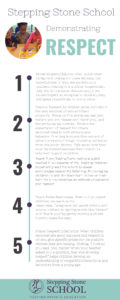Demonstrating Respect
My school-age children came home with report cards not that long ago and I noticed a section describing respectful attitudes towards school property and treatment of others. The idea of grading one’s development of this character trait seems a bit strange to me, but as I read further their report cards described respect as PR for Progressing or CD for Consistently Demonstrates.
I like the idea of progressing or consistently demonstrating respect. Children learn and often relearn the meaning of respect. This learning begins in the early years and builds throughout a child’s life.
At Stepping Stone School, we want to partner with you to encourage and teach respect to children. This month, we will focus on teaching respect as children participate in activities promoting respect for others and their property. The following are some ways we can work together to teach and encourage respect:
- Model Respect. Children often watch their caregivers looking for clues defining the expectations. If they see parents and teachers treating one another respectfully, they will do the same. Additionally, if we model respect as we speak to children, they will speak respectfully to one another.
- Discuss Respect. As children grow, talk about the way we treat others and their property. Focus on the words we use (yes, ma’am; yes, sir; please, and thank you), and the attitudes we portray. Explain the expectation of respect for others demonstrated in both attitude and behavior. One idea is to practice respect of other’s property by checking out books from the public library. Talk about how they must be treated because they have to be returned in good condition.
- Teach Turn-Taking. Turn-taking is a skill needed in all aspects of life. Helping children to patiently wait for a turn to speak encourages respectful listening. Encouraging children to wait for their turn in line or their turn for a toy develops an attitude of patience and respect.
- Teach Polite Responses. Even our youngest children can learn polite responses. Caregivers can assist infants and young toddlers in signing words like, “please” and “thank you” by gently moving a child’s hand to make the sign. At Stepping Stone School, we begin teaching these signs in our infant classrooms and continue to build upon these important phrases throughout the prekindergarten years. As children begin vocalizing, adding phrases to their vocabulary like, “excuse me,” “no, thank you,” and “yes, ma’am/sir” continues to encourage an attitude of respect.
- Praise Respectful Behavior: When children demonstrate good manners and respect to others, give specific praise for the positive choices they are making. Stating, “I noticed you said, ‘yes, ma’am’ when your teacher asked you a question, that was showing respect” helps children develop an understanding of respectful interactions and behaviors from a young age.
Teaching respect will take time and consistency. Together we can help children move from progressing to consistently demonstrating this important character trait in their daily interactions.

Resources:
Ask Dr. Sears. (2013, August 23). “7 Ways to Teach Your Child Manners.” Retrieved on February 18, 2016 from http://www.askdrsears.com/topics/parenting/discipline-behavior/morals-manners/7-ways-teach-your-child-manners
Kear, N. (2010). “The Return of Respect!” Retrieved on February 18, 2016 from www.parents.com/toddlers-preschoolers/development/manners/the-return-of-respect/
Silverman, R. (2008, April 12). “10 Tips on Teaching Respect to Children: You can’t get it if you don’t give it!” Retrieved on February 18, 2016 from http://drrobynsilverman.com/parenting-tips/10-tips-on-teaching-respect-to-children-you-cant-get-it-if-you-dont-give-it/
VanClay, M. (2007). “The respectful child: How to teach respect.” Retrieved on February 18, 2016 fromhttp://www.babycenter.com/0_the-respectful-child-how-to-teach-respect_64686.bc